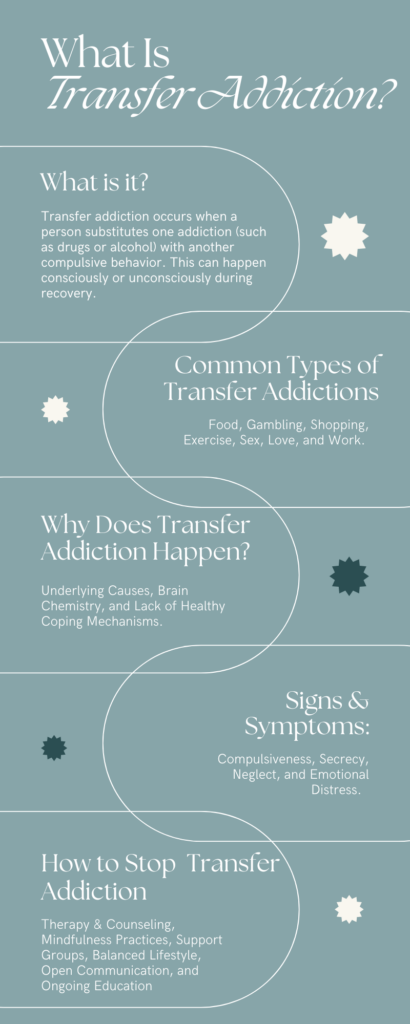Recovery from addiction is a journey filled with challenges and triumphs. While overcoming a primary addiction is a significant achievement, the journey doesn’t always end there. Many individuals in recovery may encounter what is known as “transfer addiction” or “addiction transfer,” where the compulsion to use substances or engage in addictive behaviors shifts from one addiction to another. Understanding transfer addiction is crucial for sustaining long-term recovery and maintaining a healthy, balanced life.

In this blog, we’ll explore the concept of transfer addiction, discuss why it happens, identify common forms it can take, and provide strategies for managing and preventing it. We’ll also discuss the importance of addressing the underlying issues that contribute to addiction and how recognizing and treating transfer addiction can lead to a more successful recovery.
What is Transfer Addiction?
1. Definition and Overview
Transfer addiction, also known as cross-addiction, occurs when an individual who has overcome one addiction substitutes it with another addictive behavior. This can happen when the emotional or psychological needs that were once met by the primary addiction are redirected to a new, often more socially acceptable, activity or substance. Although the new addiction might seem less harmful at first, it can still disrupt a person’s life and hinder their recovery.
Quote: “Transfer addiction is like replacing one chain with another. You may think you’re free, but you’re still bound.”
2. Why Does Transfer Addiction Happen?
Transfer addiction happens for several reasons, many of which are rooted in the psychological and emotional aspects of addiction:
- Unaddressed Underlying Issues: If the underlying issues that contributed to the original addiction, such as trauma, anxiety, or depression, are not fully addressed, the individual may turn to another substance or behavior to cope.
- Dopamine Replacement: Addiction often involves the brain’s reward system, where dopamine plays a key role. When the original addiction is removed, the brain may seek other ways to achieve similar dopamine release, leading to new addictive behaviors.
- Coping Mechanisms: In recovery, individuals may struggle to find healthy coping mechanisms to deal with stress, boredom, or emotional pain. Without these, they may fall back into addictive patterns with a different substance or behavior.
Common Forms of Transfer Addiction
1. Substance Substitution
One of the most common forms of transfer addiction is substituting one substance for another. For example, an individual who has overcome an alcohol addiction might turn to smoking or prescription medications as a way to fill the void left by alcohol. Even though the new substance might be legal or socially acceptable, it can still become addictive and harmful.
Example: A person who quits smoking may start consuming excessive amounts of caffeine as a way to cope with the cravings and stress associated with quitting.
2. Behavioral Addictions
Transfer addiction doesn’t always involve substances. It can also manifest as behavioral addictions, where an individual becomes compulsively engaged in certain activities. These behaviors can range from seemingly harmless activities to those with significant consequences.
Common Behavioral Addictions:
- Gambling: An individual might turn to gambling as a way to seek the thrill or escape once provided by their primary addiction.
- Shopping: Compulsive shopping, also known as retail therapy, can become an addiction as it provides a temporary emotional boost.
- Eating Disorders: Food can become a substitute for drugs or alcohol, leading to disordered eating patterns or an addiction to certain foods.
- Exercise Addiction: While exercise is generally healthy, some individuals may develop an addiction to the endorphin rush associated with intense workouts.
3. Technology and Social Media
In today’s digital age, technology and social media have become common outlets for transfer addiction. Individuals in recovery may find themselves spending excessive amounts of time online, seeking validation through social media, or becoming addicted to gaming or streaming.
Example: A person who has stopped using drugs may begin spending countless hours playing online games, seeking the same sense of reward and escape.
The Dangers of Transfer Addiction
1. Impact on Recovery
Transfer addiction can undermine recovery by perpetuating addictive behaviors and preventing the individual from addressing the root causes of their addiction. This can lead to feelings of guilt, shame, and frustration, which may trigger a relapse into the original addiction.
Quote: “Transfer addiction is a detour on the road to recovery, but it can lead you back to where you started if left unchecked.”
2. Health Risks
While some forms of transfer addiction may seem less harmful than the original addiction, they can still pose significant health risks. For example, gambling addiction can lead to financial ruin and mental health issues, while an exercise addiction can result in physical injury and burnout.
Example: An individual who becomes addicted to food as a replacement for alcohol may experience weight gain, diabetes, or other health complications.
Strategies for Managing and Preventing Transfer Addiction
1. Identifying and Acknowledging Transfer Addiction
The first step in managing transfer addiction is recognizing it. It’s important to be aware of any new compulsive behaviors or substances that may be taking the place of the original addiction. Acknowledging these behaviors is crucial for addressing them before they become problematic.
Tip: Keep a journal of your daily habits and emotions to identify any patterns that may indicate a transfer addiction.
2. Addressing Underlying Issues
Transfer addiction often occurs when the underlying psychological or emotional issues that contributed to the original addiction are not fully addressed. Therapy, counseling, and support groups can help individuals explore and resolve these issues, reducing the likelihood of developing a new addiction.
Tip: Consider seeking therapy that focuses on the underlying causes of addiction, such as cognitive-behavioral therapy (CBT) or trauma-informed therapy.
3. Developing Healthy Coping Mechanisms
Finding healthy ways to cope with stress, boredom, and emotional pain is essential for preventing transfer addiction. Activities such as mindfulness, meditation, creative pursuits, and physical exercise can provide positive outlets for emotions and reduce the reliance on addictive behaviors.
Tip: Experiment with different hobbies and activities to find what helps you relax and cope with stress in a healthy way.
4. Building a Strong Support System
Having a strong support system can make a significant difference in preventing and managing transfer addiction. Friends, family, support groups, and therapists can provide encouragement, accountability, and guidance during challenging times.
Tip: Stay connected with your support network and don’t hesitate to reach out for help if you notice signs of a new addiction.
Conclusion
Transfer addiction is a common challenge in the recovery journey, but with awareness and proactive strategies, it can be managed effectively. By understanding the causes and risks of transfer addiction, and by addressing the underlying issues that contribute to addictive behaviors, individuals in recovery can maintain their sobriety and lead healthier, more fulfilling lives.
At Aligned Living, we recognize the complexities of recovery and the importance of ongoing support. Our virtual mental health and drug rehab aftercare program is designed to help you navigate the challenges of recovery, including the risk of transfer addiction. With personalized care and a compassionate approach, Aligned Living is here to support you every step of the way, helping you stay on the path to lasting recovery.
If you’re ready to take control of your recovery journey and build a life free from addiction, reach out to Aligned Living today. Together, we can help you achieve your goals and create a balanced, healthy future.

